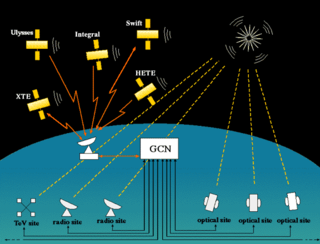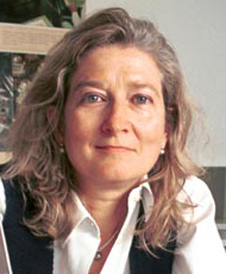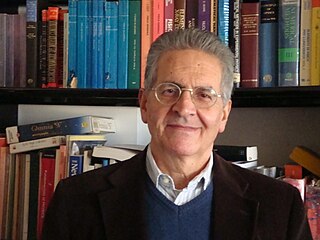Related Research Articles

The Fermi Gamma-ray Space Telescope, formerly called the Gamma-ray Large Area Space Telescope (GLAST), is a space observatory being used to perform gamma-ray astronomy observations from low Earth orbit. Its main instrument is the Large Area Telescope (LAT), with which astronomers mostly intend to perform an all-sky survey studying astrophysical and cosmological phenomena such as active galactic nuclei, pulsars, other high-energy sources and dark matter. Another instrument aboard Fermi, the Gamma-ray Burst Monitor, is being used to study gamma-ray bursts and solar flares.

Jeffrey Alan Hoffman is an American former NASA astronaut and currently a professor of aeronautics and astronautics at MIT.

NASA's series of Great Observatories satellites are four large, powerful space-based astronomical telescopes launched between 1990 and 2003. They were built with different technology to examine specific wavelength/energy regions of the electromagnetic spectrum: gamma rays, X-rays, visible and ultraviolet light, and infrared light.

Eugene Newman Parker was an American solar and plasma physicist. In the 1950s he proposed the existence of the solar wind and that the magnetic field in the outer Solar System would be in the shape of a Parker spiral, predictions that were later confirmed by spacecraft measurements. In 1987, Parker proposed the existence of nanoflares, a leading candidate to explain the coronal heating problem.
The Bruno Rossi Prize is awarded annually by the High Energy Astrophysics division of the American Astronomical Society "for a significant contribution to High Energy Astrophysics, with particular emphasis on recent, original work". Named after astrophysicist Bruno Rossi, the prize is awarded with a certificate and a gift of USD $500, and was first awarded in 1985 to William R. Forman and Christine Jones Forman "for pioneering work in the study of X-ray emission from early type galaxies". It has been awarded 40 times. In 2010, the prize was awarded to William B. Atwood, Peter Michelson and the Fermi Gamma-ray Space Telescope team "for enabling, through the development of the Large Area Telescope, new insights into neutron stars, supernova remnants, cosmic rays, binary systems, active galactic nuclei, and gamma-ray bursts". In 2013, the prize was awarded to Roger W. Romani of Leland Stanford Junior University and Alice Harding of Goddard Space Flight Center for their work in developing the theoretical framework underpinning the many exciting pulsar results from Fermi Gamma-ray Space Telescope.

The General Coordinates Network (GCN), formerly known as the Gamma-ray burst Coordinates Network, is an open-source platform created by NASA to receive and transmit alerts about astronomical transient phenomena. This includes neutrino detections by observatories such as IceCube or Super-Kamiokande, gravitational wave events from the LIGO, Virgo and KAGRA interferometers, and gamma-ray bursts observed by Fermi, Swift or INTEGRAL. One of the main goals is to allow for follow-up observations of an event by other observatories, in hope to observe multi-messenger events.

NASA's Education and Public Outreach (E/PO) group at Sonoma State University, founded in 1999, is a provider of educational materials for students, educators, scientists, and the public. Funded by NASA and the United States Department of Education, employees work together to create educational guides, fact sheets, worksheets, posters, games, and informational websites. Most of these educational materials are related to the four major missions that support the group: Fermi Gamma-ray Space Telescope, Swift Gamma-Ray Burst Mission, XMM-Newton, and NuSTAR.

Dr. Kimberly A. Weaver is an American astrophysics astronomer and professor. She has worked with NASA on several research projects. She is often seen on television programs about astronomy. She is an expert in the area of x-ray astronomy.

Cornelis A. "Neil" Gehrels was an American astrophysicist specializing in the field of gamma-ray astronomy. He was Chief of the Astroparticle Physics Laboratory at NASA's Goddard Space Flight Center (GSFC) from 1995 until his death, and was best known for his work developing the field from early balloon instruments to today's space observatories such as the NASA Swift mission, for which he was the principal investigator. He was leading the WFIRST wide-field infrared telescope forward toward a launch in the mid-2020s. He was a member of the National Academy of Sciences and the American Academy of Arts and Sciences.

Gamma-ray astronomy is the astronomical observation of gamma rays, the most energetic form of electromagnetic radiation, with photon energies above 100 keV. Radiation below 100 keV is classified as X-rays and is the subject of X-ray astronomy.

Patrizia Caraveo is an Italian astrophysicist.

Beth A. Brown was a NASA astrophysicist with a research focus on X-ray observations of elliptical galaxies and black holes. She earned a Ph.D. in Astronomy from the University of Michigan in 1998, becoming the first African-American woman to do so.
Carole Mundell is an observational astrophysicist who researches cosmic black holes and gamma ray bursts.

Padi Boyd is an American astrophysicist. She is the head of NASA's Exoplanets and Stellar Astrophysics Laboratory and an Associate Director at the Goddard Space Flight Center. She is the project scientist for NASA's Transiting Exoplanet Survey Satellite (TESS) mission.

Rita M. Sambruna Commander OMRI (Hon) is an Italian-American astrophysicist and is the Deputy Director of the Astrophysics Science Division at National Aeronautics and Space Administration's (NASA) Goddard Space Flight Center. From September 2022 to May 2023, she was the Acting Deputy Director of the Science Exploration Directorate at Goddard. Rita held the Clare Boothe Luce Professorship in Physics and Astronomy at George Mason University in 2000-2005.

Anne L. Kinney is an American space scientist and educator. Kinney is currently the Deputy Center Director at NASA Goddard Space Flight Center. Previously, she held positions as the head of the Directorate for Mathematical and Physical Sciences (MPS) for the National Science Foundation (NSF), the Chief Scientist of the W.M. Keck Observatory, Director of the Solar System Exploration Division at NASA Goddard Space Flight Center, Director of the Origins Program at NASA Jet Propulsion Laboratory, and Director of the Universe Division at NASA Headquarters. She earned a bachelor's degree in astronomy and physics from the University of Wisconsin-Madison and a doctorate in astrophysics from New York University, and has published more than 80 papers on extragalactic astronomy. She was an instrument scientist for the Faint Object Spectrograph that flew on the Hubble Space Telescope.
Julie McEnery is an astrophysicist at the Goddard Space Flight Center where she is the senior project scientist for the Nancy Grace Roman Space Telescope. Until 2020 she was the project scientist for the Fermi Gamma-Ray Space Telescope. McEnery received a PhD in Experimental Physics from University College Dublin in 1998. For her PhD, she observed the galaxy Markarian 421. She is a fellow of the American Physical Society, and an adjunct professor of physics at The University of Maryland and George Washington University. McEnery has spoken about how she admires Nancy Roman.
Brenda Lynn Dingus is an American particle astrophysicist at the Los Alamos National Laboratory, known for her research on gamma-ray bursts and cosmic rays.
Elizabeth Anne Hays is an American astrophysicist at the NASA Goddard Space Flight Center, where she is chief of the Astroparticle Physics Laboratory and the project scientist for the Fermi Gamma-ray Space Telescope. Her research has included gamma-ray astronomy of the Crab Nebula, novae, and gamma-ray bursts.

Filippo Frontera is an Italian astrophysicist and professor, who deals with astronomical investigations on celestial gamma-rays.
References
- ↑ Lucas, Chuck (2009). "Dr. Lynn Cominsky, Astrophysicist/Rancher" (PDF). Penngrove Proud. p. 14. Retrieved August 5, 2017.
- ↑ "Lynn Cominsky | Iaf". www.iafastro.org. Retrieved 2017-07-13.
- ↑ "NASA - Dr. Lynn Cominsky - NASA Fermi Astrophysicist, Fermi Press Officer, and Education and Public Outreach Lead". www.nasa.gov. Retrieved 2017-07-13.
- ↑ "Lynn Cominsky | Iaf". www.iafastro.org. Retrieved 2017-07-13.
- ↑ "E/PO Announces New Name: EdEon". School of Science and Technology at Sonoma State University. 2020-03-27. Retrieved 2023-10-05.
- ↑ "Dr. Lynn R Cominsky". Department of Physics & Astronomy at Sonoma State University. 2021-06-17. Retrieved 2023-10-05.
- ↑ "People You Should Know: Dr. Lynn Cominsky". www.northbaybiz.com. Retrieved 2017-07-13.
- ↑ "5 Things About Me: Astronomer Lynn Cominsky". AAAS - The World's Largest General Scientific Society. 2016-06-10. Retrieved 2017-07-13.
- ↑ Cominsky, Lynn; McLin, Kevin; Simonnet, Aurore; Fermi Education and Public Outreach team (2013-02-28). "Twelve Years of Education and Public Outreach with the Fermi Gamma-ray Space Telescope". arXiv: 1303.0042 [astro-ph.IM].
- ↑ "Astrophysicist/Educator Lynn Cominsky Wins Three Awards". www.spaceref.com. Retrieved 2017-07-13.
- ↑ "WOMEN IN AEROSPACE HONORS SIX EXCEPTIONAL WOMEN WITH ITS 2014 AWARDS" (PDF). Women In Aerospace. September 5, 2014. Retrieved 2017-07-13.
- ↑ "Lynn Cominsky – EdEon" . Retrieved 2024-03-27.
- ↑ "Past Awardees". www2.calstate.edu. Retrieved 2017-07-13.
- ↑ "AAS Fellows". AAS. Retrieved 27 September 2020.